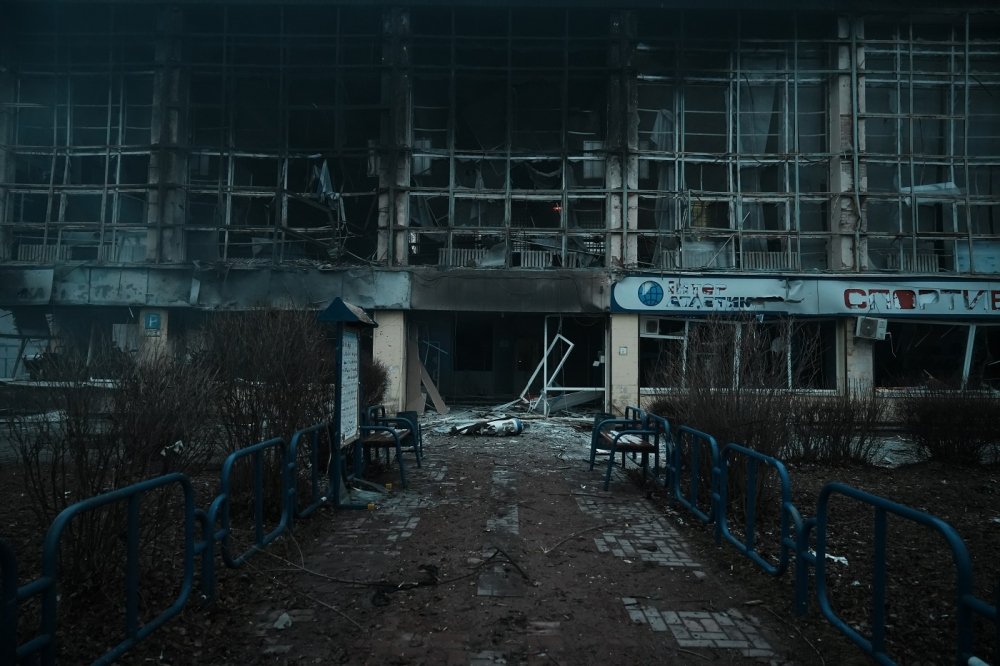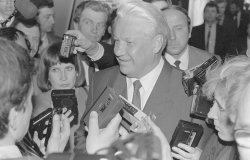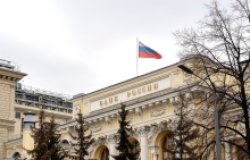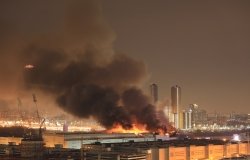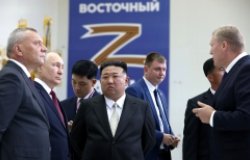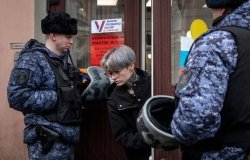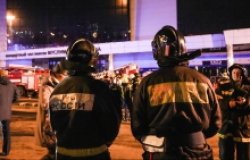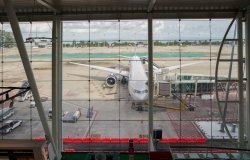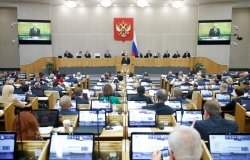
A blog of the Kennan Institute
No Options Are on the Table. How the Bomb Robs Countries of Their Future
BY ANDREI BABITSKY
There are quite a few good reasons to worry about the bomb. Russian officials keep repeating that they are only going to use it if there’s an “existential threat” to Russia (i.e., if they lose power), but my ear, trained by years of being lied to, captures the only meaningful words: “We are going to use it.” As they used to say in the Realpolitik circles, all options are on the table. It is a genuine concern of mine, and I would probably pay more attention to it were it not for the fact that the whole design of nuclear detention, every gadget of the nuclear triad, was crafted exactly so that no journalist or pundit could affect the inevitable outcome.
There is another reason for worry, much smaller yet much more significant: Could they use a tactical bomb, something presumably a little bit less destructive for the world as a whole but exactly as unimaginably cruel and enormous as a big nuclear war?
I have heard people discussing such a possibility a number times over the last four months, and at some point I couldn’t help thinking about it myself. Is it really possible? Are they mad enough to cross that line? What would the world do if it happens? Do they know, in the Kremlin, what the world would do? How can such a thing ever come to any good if it does happen?
I don’t know for sure whether the “tactical” use of nuclear weapons is possible now, but it was possible once.
The philosopher Jonathan Glover uses the term “moral slide” to talk about this. In the beginning, before nukes were invented, there were debates, both across the political spectrum and within the Allied air forces, about whether the bombing of residential areas was justifiable at all.
The hawks won, and the bombings of German cities increased. Before Enola Gay, the Allies annihilated Hamburg, Tokyo, and Dresden with the usual “conventional” bombs, and the number of victims of these raids was comparable to the toll of the Hiroshima and Nagasaki bombings.
Some of these bombings, such as the destruction of Dresden in February 1945, when the war was all but won, were not justifiable on any grounds, tactical or otherwise. It was a sheer moral slide. The general public and army officers grew more and more tolerant of the deaths of noncombatants until it no longer was a question of any real importance. It was an existential question in the original meaning of the adjective, not in the parlance of the Russian Security Council.
It took four years before the Allies were willing to completely dehumanize the enemy population. It has taken just four months for the Russian Air Force to do so.
Or just four weeks. Mariupol theater, with hundreds of civilians sheltering inside, was targeted on March 16. The Bucha massacre happened in March too, and the Kramatorsk rail station was bombed in early April. As of now, the horrific murder of noncombatants, as in the Kremenchug mall, hardly makes the Russian Army even pretend it owes anybody an explanation.
That means that dozens of officers in the Russian Air Force have already completed the moral slide. The person who orders the strikes, General Sergey Surovikin, built a successful career after being investigated for alleged war crimes multiple times. I don’t know whether people like him have a say in the decision to use tactical nukes, but they probably do, as they did in 1945. I still hope the idea is not even being discussed, but everything we know about Russian war tactics and the people involved suggests they are the worst people to trust.
Finally, there is one somewhat more detached, though hotly debated, question. It is widely believed in Ukraine that the war would not have happened if Ukraine still had the nuclear weapons it gave away, under pressure from both the Kremlin and NATO, in 1994.
At the time, Russia, the UK, and the United States promised to respect the territorial integrity of the three post-Soviet countries that ditched the bomb: Ukraine, Kazakhstan, and Belarus. Russia’s invasion of Ukraine is, of course, a flat violation of that obligation, as were the annexations of Crimea and Donetsk eight years ago.
It’s hard to debate in hypotheticals, but I am not sure the possession of nuclear weapons by Ukraine would have stopped the invasion. It is even conceivable that the invasion might have happened earlier, as Putin might have acted on his carefully crafted delusion that “the Nazis” in Kyiv should be disarmed and his belief that the rest of the world would prevent Ukraine from using nuclear weapons as an actual counterthreat.
But one thing is not up for debate: after the Budapest Memorandum of 1994 on security assurances was signed, then subsequently torn up by Russia, the two other signatories, namely, the UK and the United States, should consider any nuclear attack on Ukraine as an attack on their own soil.
Groundhog Days
That’s the paradox of the bomb. It’s the most sought-after thing in the world and the most feared at the same time. And despite the fear, it is generally assumed the bomb is a never used but always beneficial thing to have. Any country that possesses a nuclear weapon is better off than a country that doesn’t.
But are there downsides to having the most powerful thing in the world? As it looks from the year 2022, there are plenty.
We have limited information on the military effects of nuclear bombs as they were used just twice (or two times more than they should have been used), and both times after the war was already won. The physics of the phenomenon are ruthlessly clear, and they are felt by the bombed.
We are not sure, however, what the political consequences of having a bomb are. Not many countries have built them, and even fewer were able to give them away. If countries can have virtues, ditching the bomb is the most commendable thing; nothing can beat it. But is it pragmatic? Kazakhstan hints it is.
A recent book, Atomic Steppe, by Togzhan Kassenova tells the story. For forty years, from 1949 to 1989, the steppes around the city of Semipalatinsk were routinely used for nuclear tests. While the USSR built its common nuclear shield, it was mostly Kazakhstan that bore the suffering. Hundreds of thousands of people around the test sites were born with grave medical problems or got sick later.
Even the dying USSR, on the brink of economic collapse, insisted on going on with the tests, but the times had already changed, and in the late 1980s there appeared a movement in the republic that wanted to stop the tests.
It was a motley crew of diverse people—local activists, engineers, the intelligentsia—who felt that the harm from the tests was irreversible. Humans suffered, but nature did too. At some point a local activist asked a Soviet general: “‘Do you know how many groundhogs have died since testing began?’ — ‘What groundhogs?!’ — asked the general, taken aback.” And with that, the future of the polygon was sealed.
The protest that later grew, in collaboration with American activists, into the Nevada-Semipalatinsk movement enjoyed wide public support. Nursultan Nazarbayev, the man who was to rule Kazakhstan for the next thirty-plus years, used it as a negotiating point with Moscow. And the tests stopped.
A few years later independent Kazakhstan found itself in possession of one of the largest nuclear arsenals in the world. Both Russia and NATO pressured the young country to give it away, partly because it felt very probable at the time that the deadly weapons would be sold to unsuitable buyers by corrupt or very poor officers. In exchange for this, Kazakhstan could hope to get credits, investments, and integration into the world economy.
There were people who wanted to assume control of the arsenal, and Nazarbayev himself talked at the time about the geographic insecurity of the country. But the open approach quickly prevailed, at least partly because the people of Kazakhstan knew all too well the dark side of nuclear weapons.
Even if Kazakhstan might possibly not have managed a nuclear arsenal efficiently, Ukraine almost certainly could. “The question seems to have been not whether Ukraine would be capable to acquire launch control but rather how long it would take and how much it would cost,” write Polina Sinovets and Mariana Budjeryn.
There were people in Ukraine who thought giving away the nuclear deterrence would be “romantic and premature,” but there were far more who vividly remembered Chernobyl. The nuclear temptation, it seems, spared the people who happened to have a front-row view of the radiation at work.
Of course, for both Ukraine and Kazakhstan, it also came down to the economy. Without joining the Nuclear Non-proliferation Treaty they couldn’t build sound economic relationships with most other countries, exchange technologies, or receive investments and credits. It was a choice between safe isolation and insecure communication with the world.
Today Kazakhstan makes wonders of diplomacy as it continues to trade over an open border with Russia while still refusing to support the war. It has even managed a transition of power uncommon in that part of the world: Nazarbayev has finally left after thirty years at the helm. For its part, Ukraine is clearly the most admired country in the world, thanks to its skills as much as to its tragic predicament. Meanwhile, the winner of the nuclear negotiations of the 1990s, Russia, is completely safe, isolated, and universally despised.
There can be many downsides to having the bomb, but here’s the important one. It not only threatens and tortures the neighboring people: it also hurts its own. Ukraine’s present is gloomy, but it has a future, as does Kazakhstan. Russia, on the other hand, doesn’t seem to have a future. It had traded it for the warm safety of the bomb.
The most prescient political analysis of the bomb was written just two months after Hiroshima. In October 1945 George Orwell published his essay “You and the Bomb” in which he made the famous argument that the bomb fosters tyranny, serving as a mighty tool for concentrating power in the hands of the few hardly democratic governments that can never be toppled.
Details differ, but Orwell’s general thesis still holds true: the possession of a large nuclear arsenal ensures that a few powerful autocrats can cling to power indefinitely, never challenged from the outside and rarely from the inside. The political world map described in the novel 1984 was a product of this view: the world was divided between three superpowers that were permanently at peace with each other, which was “not really peace.”
It was Orwell, too, who coined the term Cold War, and the geopolitical implications of his essay have been discussed many times. But for me, the political implications are of greater importance: the bomb threatens others, but it first and foremost hurts the people who own it. Russia is being robbed of its future, thanks to its nuclear arsenal, while Ukraine and Kazakhstan have a future. And if the greater world did more to ensure that this future comes, that would do more for non-proliferation than has ever been done.
The opinions expressed in this article are those solely of the author and do not reflect the views of the Kennan Institute.
About the Author

Andrei Babitsky
Journalist; Host of “Snova Nikogda” podcast

Kennan Institute
The Kennan Institute is the premier US center for advanced research on Russia and Eurasia and the oldest and largest regional program at the Woodrow Wilson International Center for Scholars. The Kennan Institute is committed to improving American understanding of Russia, Ukraine, Central Asia, the Caucasus, and the surrounding region though research and exchange. Read more
